The
Captains' Houses
The Captains' Houses, Grimwade Street
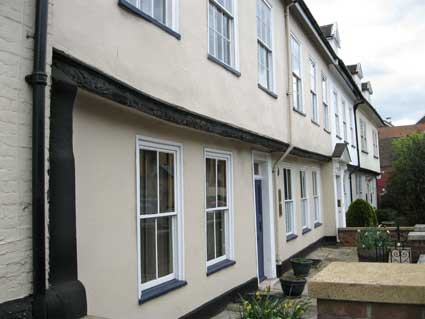
The very long, decorative beam which runs along the jettied
upper story of this building bears some readable
characters, but it has taken until April 2012 to discover these
intials to the left of the main entrance:
'RS'
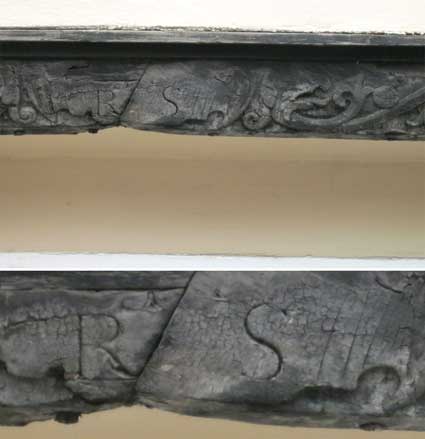
[UPDATE April 2015: Dr James Bettley's excellent
updated Pevsner for Suffolk: East (see Reading
List) tells us that 'R.S.' stands for Captain Robert Sansom.]
This beam is more clearly dated in the carved decoration: '1631'.
The long beam
runs
from No. 79 to No. 83, with the date shield above the entrance to No.
81;
it is curved with age and building movement over the centuries, but the
sharpness of the carving is remarkable. It is reputed to be the longest
known carved bressumer. Explanation: A
breastsummer,
summer
beam is a load-bearing beam
in a timber-framed building. The word summer derives from sumpter or
French sommier, "a pack horse", meaning "bearing great burden or
weight". Can also be spelt 'bressumer'.

The building bears an Maritime Ipswich 1982
plaque telling us that it was called ' "The Captains' Houses": reputed
homes of 17th century sea captains'. It's also on our Plaques page.
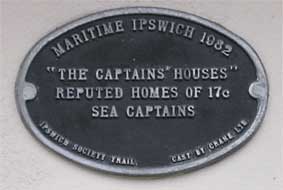
See our plaques page for the
full set of ten Ipswich Society Maritime Ipswich
1982 plaques.
There's a nicely painted main porch with
another
section of beam beyond. These buildings have also been known as "The
Sea Captains' Houses".
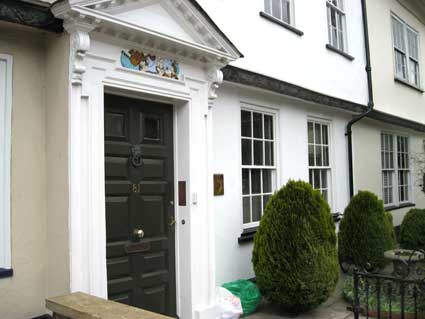
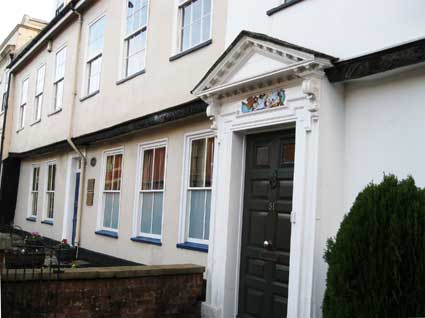 2013 images
2013 images
We learn from John Blatchly that the grandest,
most northerly of the ‘Captain’s Houses’ at no.77 Grimwade Street was
destroyed by enemy action in World War II, and the others, severely
damaged, were repaired on the advice of HM Office of Works.
The history of the street layout here is
particularly
interesting. The 'original' street came northwards from Fore Street and
made a sharp right-angle to the west to enclose the St Clement
Churchyard (the site of the present junction of Star Lane and Grimwade
Street on the Eastern Gyratory traffic system (photo on our Street furniture page). It features on
Speed's
map of the town published in 1610. This is called variously 'Church
Lane', 'St Clements Church Lane' 'Church Street' and 'St Clements
Street' on various maps. Before Argyle Street was cut through, linking
Woodbridge Road and St Helen's Street, a street called Borough Road ran
southwards from that junction, across former prison grounds (the prison
being on the site of County Hall) to
Rope Walk. This was later extended
southward past The Captains' Houses to join St Clements Street. It was
known as Borough Road until the whole stretch from St Helen's Street to
Fore Street was renamed Grimwade Street in the mid-twentieth century to
commemorate Alderman Edward Grimwade who was Mayor of Ipswich in
1964-5. He was part of several generations of Grimwades who owned the
clothiers store on the corner of Cornhill and Westgate Street and who
played parts in the civic life of the town. An 1881 map of the majority
of this area is shown on our Street
furniture page dealing with the Ipswich Corporation Waterworks.
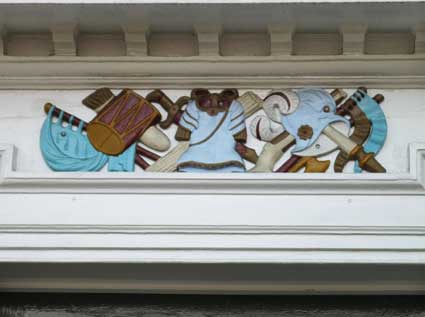
Above the door of 81 Grimwade Street is a relief of an assortment of
military artefacts:
banner, drum, quiver full of arrows, sword, tunic (the upper part looks
oddly like a teddy bear with hunched shoulders, but we think its part
of the costume), roll of matting/armour(?), blunderbuss(?),
Spanish-style helmet with
plumes, flag, quarterstaff,
pikestaff, lance(?); all rendered in a pleasantly naive style.
With successive road-building, house and factory building,
road-widening and consequent demolition, the development of Suffolk
College and many other changes it is remarkable that the Captains'
Houses have survived. They remain important and historic links with the
maritime past of the town.
There are
other dated timbers in the town in Fore
Street, Old
Cattle Market
and St
Helen's Street,
but this one seems to bear the patina of age. Around the corner in Fore
Street can be found the dated bressumer on the Isaac
Lord building.
The more modern, northern end of Grimwade Street features a tablet 'GVR
1934' on St Peter House, part of the County
Hall complex.
Home
Please email any comments
and contributions by clicking here.
©2004
Copyright
throughout the Ipswich
Historic Lettering site: Borin Van Loon
No reproduction of text or images without express written permission





 2013 images
2013 images